Europe, at Last: Part I
I left Moscow on an overnight train in the platskart class — the cheapest class available — which was like a big cattle car full of drunks, teenagers, and drunken teenagers. The beds in platskart are only about five feet long, so there are a lot of burly Russian feet dangling into the hallway at all times.
The following morning, I arrived in St. Petersburg and backpacked around town in search of a cheap place to stay, and ended up in a dark and dreary three-story hostel inhabited by only a couple fellow travelers. Few people choose to travel to Russia, and once I got there it was clear why. Russia is the only place I've ever been that I would consider anti-tourist. There isn't much of a tourist industry, and they show zero interest in ever getting one going. Getting a visa, including the fee to get "invited" into the country, costs around $130. On top of that, tourists are required to pay an additional $25 police registration fee in each city visited for more than 3 days. Once inside the country, you get very little value for your money. Major cultural sights and museums are absurdly expensive, and have a lot of hidden fees (i.e. you can't bring your backpack into the museum, but you can use the storage locker for five dollars). Basic living costs like hostels and food are costly too. If I'm going to pay nine dollars for a hot dog, that thing had better be wrapped in bacon. Finances aside, I found the people in Russia, apart from a handful of exceptions, to be tremendously unfriendly. Asking people for help or directions was nearly impossible, and people would often turn their back on me if I approached them on the street. Asking police for help or directions is even more problematic — I've heard many travelers complain about being scammed by Russian cops, who find an obscure flaw or minor error in your visa paperwork and demand you pay them hundreds of dollars in order to get your passport back. As a result, I got nervous and avoided speaking every time I passed a police officer.
All of these hurdles and annoyances aside, I did my best to enjoy Russia and St. Petersburg. I visited the world-famous Hermitage Museum on two separate occasions, which was surprisingly free for me to enter, compliments of my fake student ID card I bought on the street back in Thailand. The Hermitage is housed in the beautiful seafoam green Winter Palace, which is a nice architectural reflection of the brisk temperatures that sweep over St. Petersburg for most of the year. On my first trip inside, I wandered around trying to get a feel for the scale and scope of the massive museum, which houses an insanely large collection of everything from Egyptian mummies to classical sculptures, gilded Gothic paintings to products of the early 20th century European avantgarde. The collection is so large that if you spent five minutes contemplating each piece, you would be in the museum for more than three years. After a day of exploration, I decided to take an in-depth look at the great pieces by Rembrandt and other Dutch artists, as well as the museum's amazing collection of work from the late 19th and early 20th century from Picasso, Monet, Matisse, Rodin, and the usual suspects, which definitely rivaled any similar collection I've ever seen.
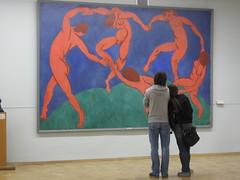

While I was in St. Petersburg, former Russian president Boris Yeltsin died, and much to my surprise, it seemed like nobody even noticed. Although talking to Russian people in English is like trying to talk to a brick wall in Piglatin, the impression that I got was that most people considered him to be a very flawed leader, causing the country more harm than good. People seem to have much more respect for current president Vladamir Putin, despite his recent heavy-handed crackdown on the free press.
My remaining time in St. Petersburg was spent wandering around in the freezing and overcast weather, trying desperately to enjoy myself. For some reason, I really had trouble connecting with St. Petersburg. Part of it definitely had to do with the language barrier — in Asia, it's much easier to deal with because you visibly look different than anyone else, so if there's trouble communicating, the local people immediately understand why. Coming into Europe and blending in, people give you dumbfounded looks when you don't understand them. While there was undoubtedly a lot of cool stuff going on in St. Petersburg, I felt like I was in a weird bubble by myself as I walked around town. For that and other reasons, the city didn't resonate with me on a personal level, despite the city's pleasant series of rivers and canals, pretty architecture city-wide, and cool Art Noveau storefronts.
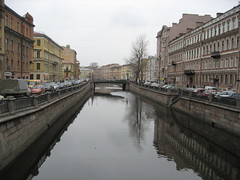
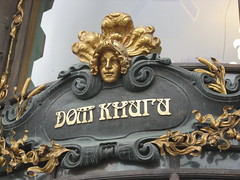
My time in Russia finally came to a close, so I packed up my stuff and headed out to the airport to catch my flight to Berlin to meet my parents. I walked a few miles from my hostel to the airport bus pickup station only to find that the airport bus no longer departed from there, and instead picked up at a faraway metro station called Moscova. Okay, no problem. I jumped on the subway and listened carefully for Muscova over the loudspeaker since the city subway amazingly has no signs on the walls indicating which station you are in. I jumped out at Moscova and hurled myself up the escalator only to find myself out in some low-density suburb. I started asking people where to go and finally found a friendly and helpful local guy who actually spoke Engish.
Airport bus? Oh, you need to be at Moscova station.
I'm not at Moscova station?!
Ha ha, oh no... this is Moscova Gate station.
!^$%)$(
He helped me get on a bus to the real Moscova station, and told me exactly how to get onto the airport bus. Once at the station, I transferred to the correct bus and confirmed that it was indeed heading to Pulkovo Airport. I could finally relax. Twenty minutes later, I arrived, went through two security checks, and then tried to check in for my flight.
Uhh, sir, you are at the wrong airport.
Isn't this Pulkovo Airport!?
Ha ha, no no, you want Pulkovo Airport II.
Are you #$%@&@# serious?
I had the check-in lady write the name of the correct airport in Cyrillic on a piece of paper, and I bolted out the door, certain I was going to miss my flight. A taxi driver waited outside with a knowing smile on his face and subsequently refused to take me to the other Pulkovo Airport — a five minute drive — for any less than 40 dollars. I had too much pride to accept the bastard's extortionate offer, so I took the bus back to Muscova station in order to switch to Bus 13, which was apparently headed for Pulkovo Airport II. They dropped me off, and I eagerly waited for Bus 13 to drive by so I could flag it down and jump on. I saw it out of the corner of my eye, jumped on, and paid my fare. I was finally on my way to the right airport — now I could finally relax. Looking around, I noticed nobody else in the minivan had luggage. Then I noticed everyone was staring at me and my big backpack. Then I looked at the sign on the bus window and saw a big backwards "15." In all the confusion, I had boarded the wrong bus.
I shouted a long enough string of obscenities to make a sailor cringe, then started banging on the doors with my hand and yelling "Nyet! Nyet! Nyet!" My fellow passengers weren't wild about the crazy person on board, so they pleaded with the the driver to pull over. He eventually did, and I flung the door open and jumped out. With my huge backpack bouncing along on my back, I started sprinting backward, trying desperately to retrace where the bus had come from, hoping I could get back to find Bus 13. Suddenly, Bus 13 appeared like a mirage, and I jumped out in front of it, waving my arms violently, jumping up and down. Somehow, I got to the airport and through the security and immigration checks in time for my flight. Thankfully, after all that, the plane was well supplied with beer because I seriously needed a drink.
I made a quick layover at the brand new airport in Riga, Latvia, then was back in the sky again headed toward my favorite city in the entire world: Berlin.
Berlin is a city of contrasts. One one hand, Berlin has a compelling and relevant modern history, serving as the central focal point of the two major mega-events of our time: World War II and the fall of the Berlin Wall — and the subsequent collapse of communism and the end of the Cold War. On the other hand, Berlin is an aggressively modern city, and is one of the leaders in the world in contemporary music, art, and design. Since more than 85% of the city's buildings were destroyed during World War II, the city is filled with a massive amount of contemporary architecture. Berlin is clean, green, liberal, friendly, and boasts one of the most extensive public transportation systems on earth. On my travels, I've found some cities hopelessly mired in the past, and some cities too forgetful of their roots. For me, Berlin gets it just right.
My first night in town was my birthday-eve, so I went out with some Swedish girls I met at the hostel for a long night of drunken shenanigans in Berlin's rapidly-gentrifying neighborhood of Mitte in east Berlin. The following morning, I sobered up and headed out to meet my parents, who cruised on over to the UK from America, and flew into Berlin that afternoon. The three of us met at a great ikea-clad apartment in the heart of West Berlin that my mom rented in the internet. We celebrated my birthday with a nice dinner on swanky Kufusterdamm street and had plenty to catch up on since I hadn't seen them in almost ten months.
The next day, we went on a walking tour which got us in-depth into the history of Berlin. Our first stop was the plaza where the Nazis famously burned piles of books they deemed inappropriate, now memorialized by an underground chamber full of empty bookshelves. Nearby is a plaque with a chilling quote written a almost a hundred years earlier by Heinrich Heine: "Wherever they burn books, they will also, in the end, burn people." Books written by Heine, interestingly enough, were among those burned in the plaza. We also stopped by Checkpoint Charlie, the only major exit and entry point during the days of the Berlin Wall, where our guide provided us with great information about how Berlin (and Europe) was divided after World War II, and how those divisions ultimately lead to the wall being built. Nearby is one of the few remaining sections of the wall that wasn't destroyed in 1989, which seems like a very distant memory for a city that no longer feels divided. We also visited the Reichstag, the building which served as the former center of power for the Third Reich, still used today by the government and now topped with a dome designed by famed architect Norman Foster. One of the highlights of the tour was the Memorial to the Murdered Jews of Europe, a simple labyrinth-like outdoor space full of gray slabs at varying heights which stand as a powerful reminder of the Holocaust without being forced or forceful.
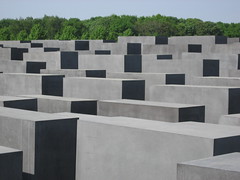
Our epic few days of sightseeing continued with a trip to the Hamburger Bahnhoff, an awesome contemporary art museum with one of the most delightful-to-pronounce museum names on the planet. Within the museum's walls were a solid collection of silkscreens by Andy Warhol, bizarre and intriguing sculptures by Joseph Beuys, markmaking exercises by Cy Twombly, and awesome assemblages by Robert Rauchenberg, one of my favorite artists. The art was so well-presented and explained that even my dad enjoyed the work on display, even though contemporary art isn't really his cup of tea. Here I am pondering the Andy Warhol's portrait of Chairman Mao — a stark contrast from the one I saw just a few weeks back hanging over the entrance to the Forbidden City in Beijing.
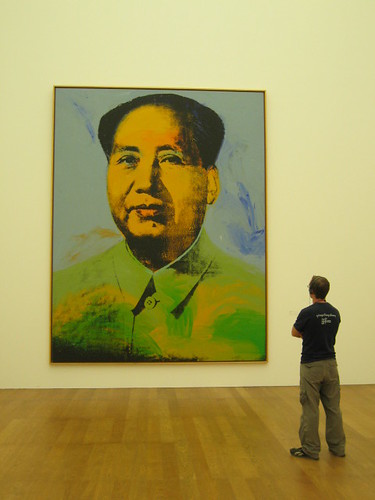
Continuing my quest to see as much of Berlin's great architecture as possible, we paid a short visit to Frank Gehry's spectacular bank interior, located just off the Brandenburg Gate, which used to sit between East and West Berlin. The outside of the building was surprisingly tame given the architect, but the inside was very, very Gehry.
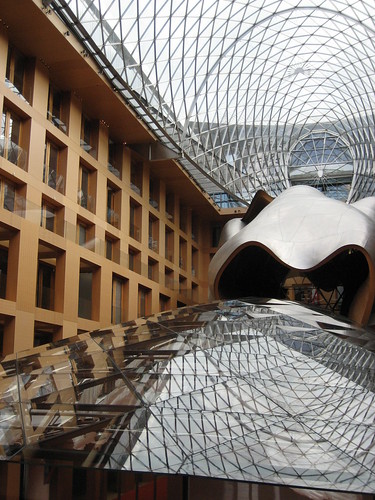
On our last day in Berlin, we headed to the Jewish Museum, designed by Daniel Libeskind, the architect of the recently completed expansion to the Denver Art Museum in my home town. The museum had beautiful spaces both outside and in.
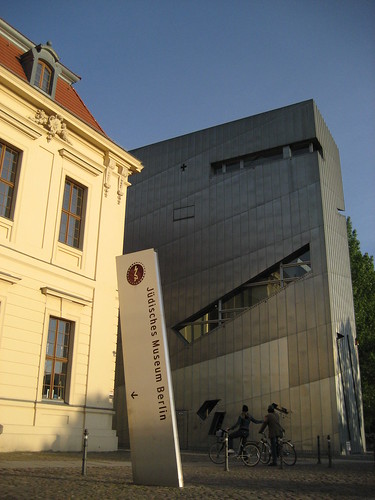
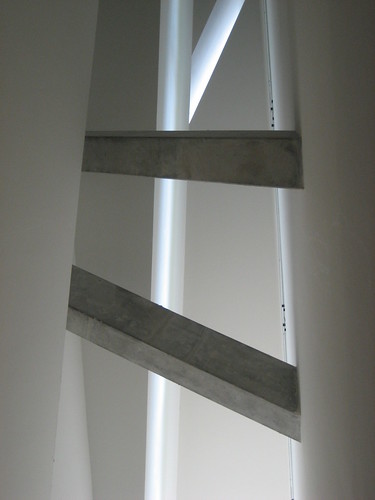
Once inside, the museum had a surprisingly fascinating look at the history of Jews throughout time, bringing their cultural traditions and history to light. With several other Holocaust museums and memorials elsewhere in the area, the Holocaust was played down a bit inside the Jewish Museum, though it obviously was talked about. I found this Holocaust memorial art installation particularly moving, which was unlike any space I've ever visited in a museum:
We visited a few other museums and galleries, but much of the rest of our time in Berlin was spent at awesome restaurants, out at beer gardens, or sitting on our balcony sipping cocktails. One of the many great things about traveling with my parents is that they need a booze break every few hours, especially if we've done a lot of walking. "My feet need a beer," as my mom says. We finally left the artistic and architectural wonderland of Berlin on a cramped overnight train across the border to Poland, and arrived in Krakow the next morning.
Our cozy apartment in Krakow was a little bit away from the old city center, so we unsuccessfully tried to figure out how to use the city's tram system, which didn't seem to lead anywhere we wanted to go. We eventually found this very honest explanation of what was going on:
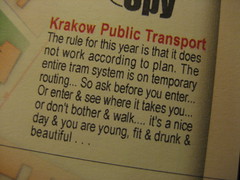
Krakow's old town is a really charming little pedestrian friendly area with a high-density of churches which serve the very devout, mostly Roman-Catholic Polish population. The streets are lined with a lot of outdoor cafes and shops, and the are filled with people strolling along next to the horse-drawn carts which clip-clop along through the historic old town. We were in Krakow during a Polish holiday, and it was fun to see vacationers from around the country touring the town alongside us.
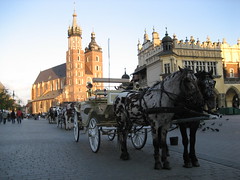
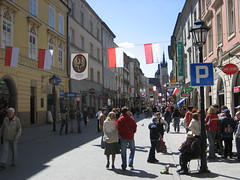
It's hard to imagine that lingering just outside of Krakow, however, lies a far-from-pleasant place: the infamous former concentration camp of Auschwitz.
I've been to a lot of Holocaust memorials and historical sites in my life, and each time, a new thread gets woven into my understanding of the horrific events that took place under the Nazis. At the Aushwitz camp, now converted into a museum and memorial, the thing that surprised me was how much paperwork the Nazis did about each person they killed. I know that probably seems kind of minor, but for me, it had a significant impact on my understanding of the Holocaust. The Nazis, as evidenced in their endless stacks of paperwork, really believed that what they were doing was right. They thought it was just. Before, I had pictured the Nazis as a bunch of guys with hate in their hearts and brains warped by a brutal dictator, killing anything in their path. Something about seeing all of that paperwork made me realize how systematic and drawn out the whole process actually was. They were really trying to exterminate a race of people — and, completely disturbingly, approached it the same way any city would approach any civic project. For me, it added another mind-numbing and sickening aspect to the most horrific event in history.
On the Auschwitz site, there are still many of the old block buildings which housed the prisoners who were fit to work. The others—the vast majority taken to the camp—were executed as soon as they arrived. We walked through the crematorium where bodies were burned, and the gas chambers where thousands of unfortunate people—Jews, gays, gypsies, Soviets, and counter-revolutionaries—met their end. We saw the painfully crowded beds where people slept if they were lucky, and the standing-room-only prison cells they were taken to if they were not. We also saw truly shocking footage of the camp during the liberation by the soviets, where the few camp survivors look far too skinny to possibly still be alive. Yet, they remained, just barely. For the three of us, it was a heartbreaking and maddening place that we will never forget.
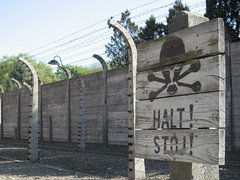
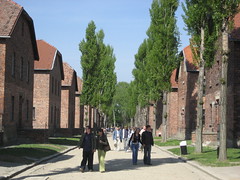
We spent our second day in Krakow going out into the 'burbs to the nearby Wieliczka Salt Mine, listed as a Unesco World Heritage site. Our walkthrough of the massive mine was led by a spunky guide who peppered the tour with salt jokes, and strangely kept accidentally referring the salt as "sugar." She later confessed that she works full-time for a sugar company, and this salt gig was just or fun. And probably also because they pay her to show up. Anyway, the tour took us through a series of underground tunnels, caverns, and massive underground churches where we were shown how salt was mined, and got a glimpse of what it would have been like to be a miner. My favorite part was the rickety ride back up to the surface on a tiny old mining elevator, which seemed downright dangerous. Here's a photo of the largest of several dark and salty underground cathedrals, in which virtually everthing was carved from salt by the miners themselves, rather than by artisans:
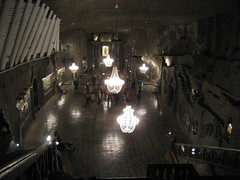
Traveling with my parents is a source of constant entertainment. I'm surprised to find that I'm not getting sick of them at all, depsite being around them pretty much 24/7. I can't even describe how nice it has been to have home-cooked meals, plentiful backrubs, and conversation with people who actually know me. Plus my dad's interactions with the locals are priceless. One of my favorites so far was with the guy behind the counter at a wine store in Krakow:
Dad: Do you speak English?
Guy: No.
Dad: Oh...
Guy: ...
Dad: Do you have... hmm.
Guy: ...
Dad: Do you have a reasonably-priced Polish wine that's not too overbearing, but that still has a nice flavor? Something not too expensive, but nothing cheap either. You know, like a nice middle of the road red, but preferably something local. Do you have anything like that?
Guy: ...
Dad: Polska vino?
Guy: No.
Dad: Oh.
We left Krakow after two days, headed for Prague on another overnight train. We stayed in a nice apartment out in Prague's suburbs, which gave us the feeling of being locals as we headed into town on the subway along with the morning commuters. For the last decade, Prague has been the darling of the world tourist circuit, and it's now a must-see on virtually every European traveler's itinerary. As a result, the city is swarming with tourists, like a big international fair with people from every corner of the globe. For better or worse, Prague feels like that little underdog rock band that suddenly burst into the mainstream.
To the city's credit, it really is as pretty as people say it is. Prague was left virtually unscathed by the bombs of World War II, and has one of the largest and most well preserved old town areas in Europe. Wandering the old town is a treat, apart from the super-touristy trinket vendors and groups of drunken Irishmen wearing "Czech Me Out!" t-shirts. Luckily, the hoardes stick to a few main paths, and we found it pretty easy to get off on a side street and meander through the old town away from the crowds.
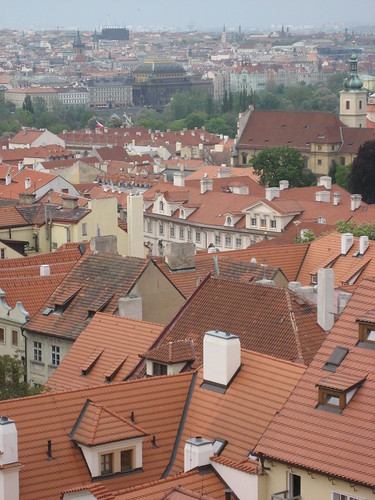
On our first day, we made our way to the Alphons Mucha museum, a tiny place dedicated to the phenomenal designer who single-handedly defined the Art Nouveau style. The walls of the museum were graced with Mucha's amazing ten-foot-tall posters for actress Sarah Bernhardt's shows at the Moulin Rouge, which made him famous among the Parisian bohemians of the day. Later in his career, he returned from the hedonism of Paris to work back in his native land, designing lots more flourished posters and even the currency notes for the new country of Czechoslovakia. I loved the museum, and I'd definitely consider among the best small-scale museums I've ever seen. After the museum, we ate at a great place which featured lots of beer, hearty Czech food, and accordian singalongs:
My parents took a day by themselves to check out Prague's castle and churches, and I went off on my own for a long day of wandering and riding around aimlessly on Prague's tram system. Along the way, I found Frank Gehry's Dancing House, a playful building which looked like its name would imply, built in the mid-1990s along the river amid a storm of controversy for its design. I thought it looked great, and felt really at home standing by the historic Art Noveau buildings next door.
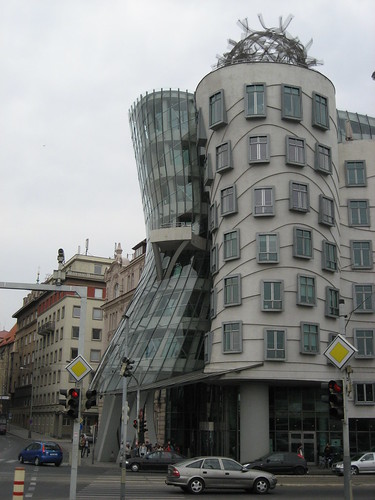
Our last day in Prague was spent touring the city's old Jewish quarter, a string of old synagogues which have amazingly been preserved to this day. One of the synagogues now houses a seriously moving Holocaust memorial — every wall is covered with handwritten names and hometowns of almost 80,000 Jews who were exterminated in the Prague-area alone during a three year span. It reminded me a bit of Maya Lin's Vietnam Memorial in Washington DC, and was equally memorable and powerful. We toured a few of the other synagogues, including the oldest in Europe, and another which was built by the Moors (the Moops). The highlight was the old cemetary where Jews for hundreds of years have been buried literally on top of each other due to a lack of space.
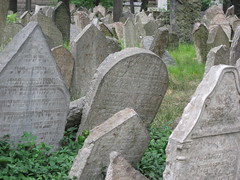
______
to be continued...
That's all I have time to write now — I'm in Paris now, and I have way better things to do than sit on the Internet. Thanks for reading, and I'll try to post another piece of this update soon! For now, my parents are keeping me insanely busy.
Ryan
5 Comments:
"If I'm going to pay nine dollars for a hot dog, that thing had better be wrapped in bacon."
Got that right, mister. Maybe even ten dollars.
Your friend,
Spectacular Gehrybot Brandenburg
Great post this time around, Nee.
Que pases bien en Paris.
un fuerte abrazo para ti.
Susie and Bill look happy and relaxed, and Ryan, you are doing an amazing job of helping the rest of us enjoy the world. Many thanks, Susan L.(old family friend)
Europe Part 2?
Great post, Ryan. It's wonderful to travel with you. Say hey to the p's. Susan L's sister (old family friend) Katy
Post a Comment
<< Home